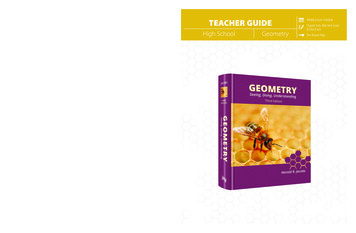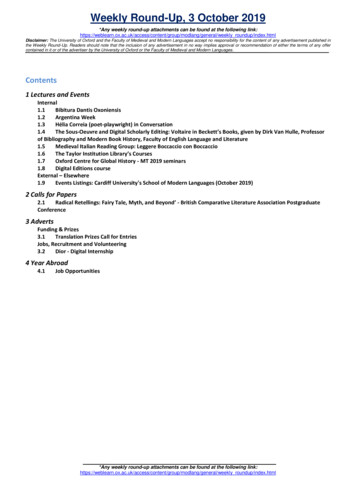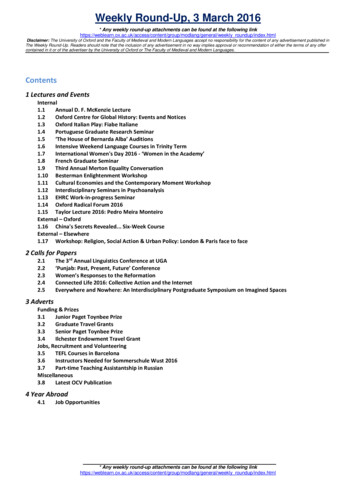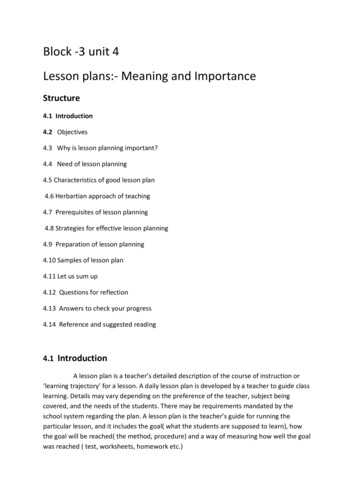
Transcription
GEOMETRY: SEEING, DOING, UNDERSTANDINGGeometry: Seeing, Doing, Understanding is designed to help the student who already has afoundational understanding of algebra to build upon this vital knowledge for geometry. ThisTeacher’s Guide includes: A convenient daily schedule with space to record grades Chapter, mid-term, and final tests for student assessment Answer keys for all tests utilized in the courseJacobs’ Geometry: Seeing, Doing, Understanding is highly regarded in the education market. Thiscurriculum provides a full year of mathematics in a clearly written format to help the instructionalprocess for teachers. It can also be used for a student’s independent study of the material.Also available: The Solutions Manual for Geometry: Seeing, Doing, Understanding by Master Books provides solutions and answers for all exercises in the course.Approximately 60 to 75 minutesper lesson, five days a weekIncludes answer keys for chaptertests, mid-term and final examsThe mid-term and final examsare included to help reinforcelearning and provide assessmentopportunitiesDesigned for grades 9 to 12 in aone-year course to earn 1 math orgeometry creditTEACHERTEACHERGUIDEGUIDEDaily schedule, tests, and test answers for the one-yearGeometry: Seeing, Doing, Understanding course.HAROLD R. JACOBS is a teacher of mathematics andscience, writer, and well-respected speaker. He receivedhis B.A. from U.C.L.A. and his M.A.L.S. from WesleyanUniversity. His other publications include Mathematics: AHuman Endeavor, Geometry: Seeing, Doing, Understandingand articles for The Mathematics Teacher and theEncyclopedia Britannica. Mr. Jacobs has received the MostOutstanding High School Mathematics Teacher in LosAngeles award, the 1988 Presidential Award for Excellencein Science and Mathematics Teaching, and many otheracknowledgments.ISBN-13: lRELIGION/Christian Education/General 29.99 U.S.TEACHER GUIDEHigh SchoolGeometryWeekly Lesson ScheduleChapter Tests, Mid-term Exam& Final ExamTest Answer KeysEAN
TEACHER GUIDEHigh SchoolGeometryWeekly Lesson ScheduleChapter Tests, Mid-term Exam& Final ExamTest Answer KeysGeometrySeeing, Doing,UnderstandingMaster Books EditionFirst printing: February 2017MASTER BOOKSCurriculumCopyright 1974 and 2017 by Harold R. Jacobs. All rights reserved. No part of thisbook may be used or reproduced in any manner whatsoever without written permissionof the publisher, except in the case of brief quotations in articles and reviews.For information write:Master Books , P.O. Box 726, Green Forest, AR 72638Master Books is a division of the New Leaf Publishing Group, Inc.ISBN: 978-1-68344-022-2ISBN: 978-1-61458-091-1 (digital)Printed in the United States of AmericaPlease visit our website for other great titles:www.masterbooks.comFor information regarding author interviews,please contact the publicity department at (870) 438-5288.Permission to reproduce this material must be requested prior to use byemail to the publisher at info@nlpg.com.
Table of ContentsUsing This Teacher Guide. 4Course Objectives. 4Course Description. 5Suggested Daily Schedule. 7Reference Pages. 17Chapter Tests and Test Answer Sheets. 39Midterm Tests. 105Final Tests. 115Answer Keys. 127This book consists of chapter tests, a midyear examination, and afinal examination that may be used with Geometry: Seeing, Doing,Understanding, Third Edition. The chapter test are designedfor an examination period of approximately 45 minutes; themidyear and final are designed for an examination period ofapproximately 100 minutes. Complete answers for all the testsare in a separate section at the end of this book.Author Bio:HAROLD R. JACOBS is teacher of mathematics and science, writer, and well-respected speaker. Hereceived his B.A. from U.C.L.A. and his M.A.L.S from Wesleyan University. His other publicationsinclude Mathematics: A Human Endeavor, Elementary Algebra and articles for The Mathematics Teacher andthe Encyclopedia Britannica. Mr. Jacobs has received the Most Outstanding High School MathematicsTeacher in Los Angeles award, the Presidential Award for Excellence in Mathematics Teaching, and wasfeatured in the book 101 Careers In Mathematics published by the Mathematical Association of America.
Using This Teacher GuideFeatures: The suggested weekly scheduleenclosed has easy-to-manage lessons that guidethe reading, course exercises, and all assessments. The pages of this guide are perforatedand three-hole punched so materials are easy totear out, hand out, grade, and store. Teachers areencouraged to adjust the schedule and materialsneeded in order to best work within their uniqueeducational program.Lesson Scheduling: Students are instructedto read the pages for each lesson in the studenttextbook and then complete the correspondingsets of exercises. Assessments include lessonexercises, chapter tests, a mid-term review, andfinal exam given at regular intervals with spaceto record each grade. Space is provided onthe weekly schedule for assignment dates, andflexibility in scheduling is encouraged. Teachersmay adapt the scheduled days per each uniquestudent situation. As the student completes eachassignment, this can be marked with an “X” inthe box.Approximately 60 to 75 minutes per lesson, five days aweekIncludes answer keys for chapter tests, mid-term and finalexamsThe mid-term and final exam are included to help reinforcelearning and provide assessment opportunitiesDesigned for grades 9 to 12 in a one-year course to earn 1math or Geometry creditCourse Objectives:How To Use This Course:DDGeometry: Seeing, Doing, Understanding isdesigned to prepare students who alreadyhave a foundational understanding of Algebrato understand and illustrate the principlesof Geometry. With the use of innovativediscussions, cartoons, anecdotes, and vividexercises, students will not only learn butwill also find their interest growing with eachlesson. The full-color student book focuseson guided discovery to help students developgeometric awareness. Geometry is all aroundus. Prepare to understand its dynamicinfluence so much better!DDThere is some flexibility in how the course isstructured for the student, where the teachercan assign all of the suggested problems,or choose portions from each set if time islimited. Both the student textbook and theSolutions Manual are crucial in completingthe course.4 Geometry: Seeing, Doing, Understanding
Course DescriptionLessons are divided into 16 chapters, covering deductive reasoning, congruence and similarity,transformations, coordinate geometry, area, geometric solids and non-Euclidean geometries, with helpfulsummaries and reviews. As the student works through the textbook, selected answers to problems areavailable in the textbook, with full solutions to all of the exercises available in the Solutions Manual for theGeometry: Seeing, Doing, Understanding course.Additional Materials NeededDDGeometry: Seeing, Doing, Understanding (student textbook).DDA notebook and graph paper are essential. It is highly recommended that students use a 3-ring binder,loose-leaf paper, and graph paper to complete the coursework. Tab dividers to separate your work bylesson are also recommended.Reference PagesThese are included from the student text, and can be removed for ease of use by the students completingthe course.TestingThere are exams provided for each chapter in this Teacher Guide. Also included are a mid-term and afinal exam. Answers for these are available in the back of this book.GradingIt is always the prerogative of an educator/parent to assess student grades however he or she might deembest. The following is only a suggested guideline based on the material presented through this course:DDEach lesson’s coursework is worth 100 points.DDAll tests within the course are worth 100 points each.To calculate the percentage of the worksheets, chapter tests, mid-term or final exam, the parent/educatormay use the following guide.Divide total number of questions correct (example: 43) by the total number of questions possible(example: 46) to calculate the percentage out of 100 possible. 43/46 93 percent correct. The suggestedgrade values are noted as follows:90 to 100 percent A80 to 89 percent B70 to 79 percent C60 to 69 percent D0 to 59 percent FGeometry: Seeing, Doing, Understanding 5
First Semester Suggested Daily ScheduleDateDayAssignmentDue Date GradeFirst Semester-First QuarterDay 1Day 2Week 1Day 3Day 4Day 5Day 6Week 2Day 7Day 8Day 9Day 10Day 11Day 12Week 3Day 13Day 14Day 15Day 16Day 17Week 4Day 18Day 19Day 20Read pages xi–2 of Geometry textbook (GEO)Complete the exercise on pages 2–6See this Teacher Guide (TG) for exams.Read Chapter 1: An Introduction to Geometry and Chapter 1,Lesson 1: Lines in Designing a City, pages 7–9 (GEO)Complete Exercise Sets I, II, and III, pages 10–12Read Chapter 1, Lesson 2: Angles in Measuring the Earth,pages 13–15 (GEO)Complete Exercise Sets I, II, and III, pages 15–17Read Chapter 1, Lesson 3: Polygons and Polyhedra: PyramidArchitecture, pages 18–20 (GEO)Complete Exercise Sets I, II, and III, page 21–23Read Chapter 1, Lesson 4: Constructions: Telling Time withShadows, pages 24–25 (GEO)Complete Exercise Sets I, II, and III, page 26–29Read Chapter 1, Lesson 5: We Can’t Go On Like This,pages 30–31 (GEO)Complete Exercise Sets I, II, and III, pages 31–34Read Chapter 1, Summary and Review, pages 35–36 (GEO)Complete Exercise Sets I, II, and III, pages 36–38Read Chapter 1, Algebra Review, page 39Complete Exercises, page 40Chapter 1 Test Study DayChapter 1 Test, pages 41–44 (TG)Review test and work for Chapter 1. Use this time to buildyour skills or work on concepts that you may be struggling tounderstand or master.Read Chapter 2, The Nature of Deductive Reasoning, andLesson 1: Conditional Statements, pages 41–43 (GEO)Complete Exercise Sets I, II, and III, pages 43–45Read Chapter 2, Lesson 2: Definitions, pages 46–47 (GEO)Complete Exercise Sets I, II, and III, pages 47–49Read Chapter 2, Lesson 3: Direct Proof, pages 50–51 (GEO)Complete Exercise Sets I, II, and III, pages 52–54Read Chapter 2, Lesson 4: Indirect Proof, pages 55–57 (GEO)Complete Exercise Sets I, II, and III, pages 57–59Read Chapter 2, Lesson 5: A Deductive System,pages 60–61 (GEO)Complete Exercise Sets I, II, and III, pages 61–64Read Chapter 2, Lesson 6: Some Famous Theorems of Geometry,pages 65–67 (GEO)Complete Exercise Sets I, II, and III, pages 67–70Read Chapter 2, Summary and Review, page 71 (GEO)Complete Exercise Sets I and II, pages 71–74Read Chapter 2, Algebra Review, page 75 (GEO)Complete Exercises, page 76Chapter 2 Test Study DayGeometry: Seeing, Doing, Understanding 7
DateDayDay 21Day 22Week 5Day 23Day 24Day 25Day 26Day 27Week 6Day 28Day 29Day 30Day 31Day 32Day 33Week 7Day 34Day 35Day 36Day 37Week 8Day 38Day 39Day 40AssignmentChapter 2 Test, pages 45–48 (TG)Review test and work for Chapter 2. Use this time to buildyour skills or work on concepts that you may be struggling tounderstand or master.Read Chapter 3, Lines and Angles and Lesson 1: NumberOperations and Equality, pages 77–79 (GEO)Complete Exercise Sets I, II, and III, pages 80–83Read Chapter 3, Lesson 2: The Ruler and Distance,pages 84–86 (GEO)Complete Exercise Sets I, II, and III, pages 86–90Read Chapter 3, Lesson 3: The Protractor and Angle Measure,pages 91–93 (GEO)Complete Exercise Sets I, II, and III, pages 93–97Read Chapter 3, Lesson 4: Bisection, pages 98–100 (GEO)Complete Exercise Sets I, II, and III, pages 100–104Read Chapter 3, Lesson 5: Complementary and SupplementaryAngles, pages 105–106 (GEO)Complete Exercise Sets I, II, and III, pages 107–109Read Chapter 3, Lesson 6: Linear Pairs and Vertical Angles,pages 110–112 (GEO)Complete Exercise Sets I, II, and III, pages 112–116Read Chapter 3, Lesson 7: Perpendicular and Parallel Lines,pages 117–118 (GEO)Complete Exercise Sets I, II, and III, pages 119–122Read Chapter 3, Summary and Review, page 123 (GEO)Complete Exercise Sets I and II, pages 124–128Read Chapter 3, Algebra Review, pages 129–130 (GEO)Complete Exercises, page 130Chapter 3 Test Study DayChapter 3 Test, pages 49–52Review test and work for Chapter 3. Use this time to buildyour skills or work on concepts that you may be struggling tounderstand or master.Read Chapter 4, Congruence and Lesson 1: Coordinates andDistance, pages 131–134 (GEO)Complete Exercise Sets I, II, and III, pages 134–138Read Chapter 4, Lesson 2: Polygons and Congruence,pages 139–141 (GEO)Complete Exercise Sets I, II, and III, pages 141–145Read Chapter 4, Lesson 3: ASA and SAS Congruence,pages 146–147 (GEO)Complete Exercise Sets I, II, and III, pages 148–150Read Chapter 4, Lesson 4: Congruence Proofs,pages 151–152 (GEO)Complete Exercise Sets I, II, and III, pages 153–156Read Chapter 4, Lesson 5: Isosceles and Equilateral Triangles,pages 157–159 (GEO)Complete Exercise Sets I, II, and III, pages 159–162Read Chapter 4, Lesson 6: SSS Congruence,pages 163–164 (GEO)Complete Exercise Sets I, II, and III, pages 165–1688 Geometry: Seeing, Doing, UnderstandingDue Date Grade
Chapter Tests and Test Answer Sheetsfor Use withGeometry: Seeing, Doing, UnderstandingNote: This section of the teacher guide contains chapter tests and answer sheets. Special thanks to DonaldM. Luepke for his contributions to the tests.
GeometryTest 1Scope:Chapter 1These figures appeared in the first printed versionof the Elements.1. Who wrote the Elements?2. What does the figure labeled “punctus”represent?The figure labeled “linea” looks like a line segment.3. What is the difference between a line and a linesegment?The figure labeled “supficies plana” looks like arectangle.4. What is the difference between a rectangle anda plane?A quadruped is an animal with four legs.5. What is a quadrilateral?6. Explain how the word pentagon would helpsomeone figure out how many athletic eventsare in the pentathlon.7. What do an octopus and an octagon have incommon?The figure below is a transparent view of atetrahedron, a polyhedron that has four faces.Total score:of 100NameBecause of its shape, this quadrilateral is called a“kite.”11. Use your straightedge and compass to bisect A, B, and C. Extend the three lines acrossthe figure.12. What relation do the three lines appear tohave to each other?13. What relation does the line that bisects Bappear to have to D?The floors of two rooms are rectangular in shape.Their dimensions are as follows.Room A: 15 feet wide, 18 feet long.Room B: 10 feet wide, 24 feet long.14. Which room has the greater perimeter?Explain.15. Which room has the greater area? Explain.8. What kind of polygon are its faces?9. How many edges meet at each corner of atetrahedron?10. Any three corners of a tetrahedron arenoncollinear. What is another word thatdescribes them?Geometry: Seeing, Doing, Understanding 41
The figure above contains an optical illusion.Use your ruler to measure the following segments,each to the nearest 0.1 cm.The figure below shows two quadrilaterals,ABCD and ABEF, drawn on the same grid;AB DC FE 4 and AD AF BC BE 5.16. FB.17. FD.Use your protractor to measure each of thefollowing angles. (You may extend the sides of theangles as necessary.)18. A.19. BFD.Your measurements reveal something surprisingabout the figure.20. What is it?This figure shows four lines that intersect in sixpoints.To find the area of a quadrilateral, the Egyptiansused the formulaA 1(a c)(b d)4in which a, b, c, and d are the lengths of theconsecutive sides.23. Use the figure to show that the Egyptianformula does not always work correctly.Extra Credit.A magician takes the three cards shown below froman ordinary deck (containing clubs, , diamonds, ,hearts, , and spades, ).21. Draw AD, BF, and CE. Use your straightedgeand compass to bisect these three linesegments. Use the letter M to label themidpoint of AD, the letter N for the midpointof BF, and the letter O for the midpoint of CE.22. What seems to be true about points M, N, andO?42 Geometry: Seeing, Doing, Understanding1. What cards do you think they are?2. Can you explain how someone might betricked with them?
GeometryTest 1Scope:Chapters 11.Total score:of ry: Seeing, Doing, Understanding 43
17.23.18.19.20.21.Extra Credit22.1.2.44 Geometry: Seeing, Doing, Understanding
GeometryTest 2Scope:Chapter 21. Name the property or definition illustrated byeach of the following equations.a) 2(3x) (2 3)xb) 4 y y 42. Write each of the following expressions as asingle integer.a) (13 – 5)2b) 132 – 523. Simplify the following expressions.a) 5x2 – x2b) (6x – y) – (x – 7y)4. Read the following statements carefully andmark them true or false.a) If a conditional statement is true, itsconverse must also be true.b) If the radius of a circle is r, its area is πr2.c) It is possible to define every word in termsof simpler words.d) To prove a b indirectly, you begin byassuming not a.e) A syllogism consists of two premises and aconclusion.5. This figure illustrates a claim that appeared ina newspaper ad.What is this type of figure called?Write the statement in “if a, then b“ form.Rewrite it in the form “b if a.”Which of the following statements is alsoillustrated by the diagram?(1) If you don’t want it, we don’t have it.(2) If you want it, we have it.(3) If we have it, you want it.6. Consider the following premises:If you watch Sesame Street, you are a kid atheart.If you are a kid at heart, you love Eskimo pies.a) What conclusion follows from thesepremises?Total score:of 100Nameb) If one of the premises is false, does it followthat the conclusion must be false?c) If both premises are true, does it follow thatthe conclusion must be true?7. The following statement is a whimsicaldefinition of egotist:You are an egotist if you are alwaysme-deep in conversation.a) What does the abbreviation “iff” stand for?b) Write the two conditional statements thatare equivalent to the definition.c) How is one of your statements related tothe other?8. The following sentence, from a Spanishgeometry book, describes geometry as adeductive system:Euclides construye la Geometría partiendode definiciónes, postulados y axiomas conlos cuales demuestra teoremas.Write the English equivalent of each of thefollowing words and tell what the wordmeans.a) definición.b) postulado.c) teorema.d) Tell what you think the sentence says.9. In this figure of a polyhedron, ABC is atriangle.a)b)c)d)Tell whether each of the following statementsis true or false.a) Points A, D, and B are collinear.b) Points A and D determine a line.c) Points B, E, and C are coplanar.d) Points B, E, and C determine a plane.e) Points A, D, and C determine a plane.Geometry: Seeing, Doing, Understanding 45
10. After studying the relations of the statementsgiven in the following proof, write the missingstatements.Theorem.If there is a total eclipse of the sun, thetemperature can be determined without athermometer.Proof.If there is a total eclipse of the sun, the skybecomes dark.a) (What is the second statement?)If the crickets think that it is night, they willstart chirping.b) (What is the fourth statement?)If the temperature is estimated by countingcricket chirps, it can be determined withouta thermometer.c) What kind of proof is this?11. Mrs. Cook purchased a set of kitchen utensilsadvertised as a stainless steel product. Afterusing the set for a few weeks, she discoveredthat some of the utensils were beginning torust. She went back to the store, claimed thatthe set was not stainless steel, and asked for arefund.In her conversation with the store manager,she used an indirect proof. Identify each of thefollowing.a) The statement she wanted to prove.b) The assumption made.c) The conclusion resulting from theassumption.d) The known fact contradictory to part c.12. In this figure, squares have been drawn on thesides of a right triangle. Given that a 16 andc 34, finda)b)c)d)the area of square A.the area of square C.the area of square B.b.46 Geometry: Seeing, Doing, Understanding13. This figure appeared in a problem on an SATexam.Given that BAC 80 , find each of thefollowing:a) x.b) ABC.c) y.d) z.14. A trundle wheel can be used to measuredistance along the ground. The distancetraveled in one revolution of the wheel isequal to the circumference of the wheel.Given that the circumference of a trundlewheel is 3 feet, finda) its diameter to the nearest 0.1 inch.b) the distance that the wheel travels inmaking five revolutions.
GeometryTest 2Scope:Chapters 2Total score:of 100Name1. a)7. a)b)b)2. a)b)3. a)c)b)4. a)8. a)b)c)b)d)e)c)5. a)b)d)c)d)6. a)9. a)b)b)c)c)d)e)Geometry: Seeing, Doing, Understanding 47
10. a)b)c)11. a)b)c)d)12. a)b)c)d)13. a)b)c)d)14. a)b)48 Geometry: Seeing, Doing, Understanding
Mid-Term and Final Testsfor Use withGeometry: Seeing, Doing, Understanding
GeometryMid-TermTest 1Scope:Chapters 1–8Write your answers to the following problems onyour answer sheet.1. Simplify: x x x.2. Use the distributive rule to eliminate theparentheses: x2(4 – x).3. Solve for x: 3(x 7) –12.4. Subtract: (9x y) – (x – y).5. Factor: 5x2 14x – 3.x–3.x2 – 97. Write as a single fraction in lowest terms:6. Reduce to lowest terms:x 2 x– .48 8. Write 72 in simple radical form.Formulas are important in geometry as well as inalgebra. Explain what each of these formulas means.9. c πd.10. A s2.The following questions refer to this statement:All porcupines have long quills.11. Write the statement in “if-then” form.12. Does it follow that an animal that has longquills is a porcupine?13. What relation does this idea have to theoriginal statement?Write the letter of the correct answer on youranswer sheet.14. If two angles of one triangle are equal to twoangles of another triangle,a) the triangles must be congruent.b) the sides opposite them are equal.c) the triangles are equiangular.d) the third pair of angles must be equal.15. If a b, which one of the followinginequalities must be true?a) a2 b2.b) a c b c.c) ac bc.d) a b 0.Total score:of 100Name16. If a quadrilateral is equiangular,a) it is also equilateral.b) it is a square.c) it is a rectangle.d) it is concave.17. Two angles are a linear pair. Which of thefollowing must be true?a) The angles are equal.b) The angles are right angles.c) The angles are supplementary.d) All of these must be true.18. If the legs of one right triangle are equal to thelegs of another right triangle, which one of thefollowing could be used to prove the trianglescongruent?a) SAS.b) ASA.c) SSS.d) HL.19. Which of the following could be the lengths ofthe sides of a triangle?a) 3, 7, 11.b) 4, 4, 8.c) 5, 12, 13.d) 6, 9, 15.20. Two lines are parallel if the interior angles thatthey form on the same side of a transversala) are right angles.b) are equal.c) are complementary.d) form a linear pair.21. If all of the exterior angles of a triangle areobtuse, the triangle must bea) obtuse.b) equiangular.c) acute.d) scalene.22. Which one of the following statements aboutthe diagonals of a parallelogram is alwaystrue?a) They are equal.b) They are longer than the sides.c) They are perpendicular.d) They bisect each other.Geometry: Seeing, Doing, Understanding 107
23. If the sides of a triangle have lengths x, x, andy, its perimeter isa) x2 y.b) 2xy.c) x y.2d) 2x y.Read the following statements carefully. If astatement is always true, write true. If not, do notwrite false. Instead, write a word or words thatcould replace the underlined word to make thestatement true. Some of the questions in this sectionmay have more than one correct answer; do notmake a change in any statement that is always truehowever.24. An obtuse triangle has two obtuse angles.25. Three noncollinear points determine a plane.26. The base angles of an isosceles trapezoid areequal.27. The converse of every theorem is true.28. The points on a line can be numbered so thatpositive number sums measure distances.29. The diagonals of a rhombus are equal.30. The word line is an undefined term ingeometry.31. If the x-coordinate of a point is 0, the point ison the x-axis.32. A pentagon is a polygon that has eight sides.33. Two angles are vertical angles if the sides ofone angle are opposite rays to the sides of theother.34. If A and B are supplementary and B and C are supplementary, than A and C aresupplementary.35. According to the Betweenness of PointsTheorem, if A-B-C, then AB BC.36. To prove a theorem indirectly, we begin byassuming that the opposite of its conclusion istrue.37. If a triangle has two equal sides, it must beequilateral.38. Two lines that do not intersect must beparallel.39. The supplement of an acute angle is acute.40. Through a point not on a line, there is exactlyone line parallel to the given line.108 Geometry: Seeing, Doing, Understanding41. The “Whole Greater than Part” Theorem saysthat if a 0, b 0, and a b c, thena c and b c.42. In a right triangle, the hypotenuse must bethe longest side.43. A square has two lines of symmetry.Use your straightedge and compass to make thefollowing constructions on your answer sheet.44. Bisect A.45. Through D, construct a line perpendicular toBC.
GeometryMid-TermTest 1Scope:Chapters 1–8Total score:of 100Name1. 5.29.2. 6.30.3. 7.31.4. 8.32.9.33.34.10.35.36.11.37.38.12.39.13.40.14. 18. 22.41.15. 19. 23.42.16. 20.43.17. 21.44/45.24.25.26.27.28.Geometry: Seeing, Doing, Understanding 109
Answers forChapter, Mid-Term and Final Tests
Chapter Test 1Euclid.1.11.A point.2.A line extends without end in3.both directions.A line segment is part of aline bounded by two endpoints.A rectangle is bounded by4.four line segments.They seem to be concurrent.12.A plane has no boundaries.It also appears to bisect D.13.A polygon that has four sides.5.The perimeter of room A is14.A pentagon has five sides, so6.2(15 ft) 2(18 ft) 66 ft.the pentathlon has five events.The perimeter of room B isAn octopus has eight arms and7.2(10 ft) 2(24 ft) 68 ft.an octagon has eight sides.Room B has the greater perimeter.Triangles.8.The area of room A is15.Three.9.(15 ft)(18 ft) 270 sq ft.Coplanar.10.The area of room B is(10 ft)(24 ft) 240 sq ft.Room A has the greater area.7.3 cm.16.Geometry: Seeing, Doing, Understanding 129
7.8 cm.17.According to the formula used23.62 .18.by the Egyptians for the area of109 .19.a quadrilateral, the area of bothFB appears to be longer than FD,20.quadrilaterals isbut it is shorter.21.11(4 4)(5 5) (8)(10) 4420 square units.This is correct for rectangle ABCD,whose area is 20 square units.If quadrilateral ABEF is cut by avertical line through point F, thetwo pieces can be rearranged toform a square with sides of 4units, so its area is actually16 square units.Extra CreditThey seem to be collinear.22.(Student answer.) Two of the1.cards are clearly the 2 and 3 ofdiamonds. The card in backcould be the ace of diamonds.Someone might think that the2.card in back is the ace ofdiamonds whereas it is actually130 Geometry: Seeing, Doing, Understandingthe ace of hearts.
Chapter Test 2property of1. a) Associativeyou watch Sesame Street,6. a) Ifmultiplication.you love Eskimo pies.propertyb) Commutativeb) No.of addition.Yes.c)– 5) 8 64.2. a) (13and only if.7. a) If– 5 169 – 25 144.b) 13you are an egotist,b) If.3. a) 4xyou are always me-deep in– x – y 7y 5x 6y.b) 6xconversation.4. a) False.If you are always me-deep inb) True.conversation, you are an egotist.False.c)One statement is thec)d) False.converse of the other.True.e)A statement that8. a) Definition.Euler diagram.5. a) Angives the meaning of a word.we don’t have it,b) IfA statementb) Postulate.you don’t want it.assumed true without proof.You don’t want it ifc)Theorem. A statement provedc)we don’t have it.by reasoning deductively.222222.d) StatementGeometry: Seeing, Doing, Understanding 131
constructed thed) Euclid 256.12. a) 16Geometry starting from 1,156.b) 34definitions, postulates and1,156 – 256 900.c)axioms with which he900 30.d) demonstrated theorems. 80, so x 40.13. a) 2x9. a) True. 180 – 80 – 30 70 .b) ABCb) True.2y 70, so y 35.c)True.c) 180 – 40 – 35 105.d) zd) False. πd, 36 πd,14. a) c22True.e)36 11.5. 11.5 inches.πthe sky becomes dark,10. a) Iffeet) 15 feetb) 5(3the crickets think that it is night.(or 180 inches).the crickets start chirping,b) Ifthe temperature is estimatedby counting cricket chirps.Direct.c)utensils are not stainless11. a) Thesteel.utensils are stainlessb) Thesteel.They will not rust.c)are rusting.d) They132
foundational understanding of algebra to build upon this vital knowledge for geometry. This . Teacher’s Guide. includes: nvenient daily schedule with space to record grades A co hapter, mid-term, and final tests for student assessmentC nswer keys for all tests utilized in the courseA Jacobs










